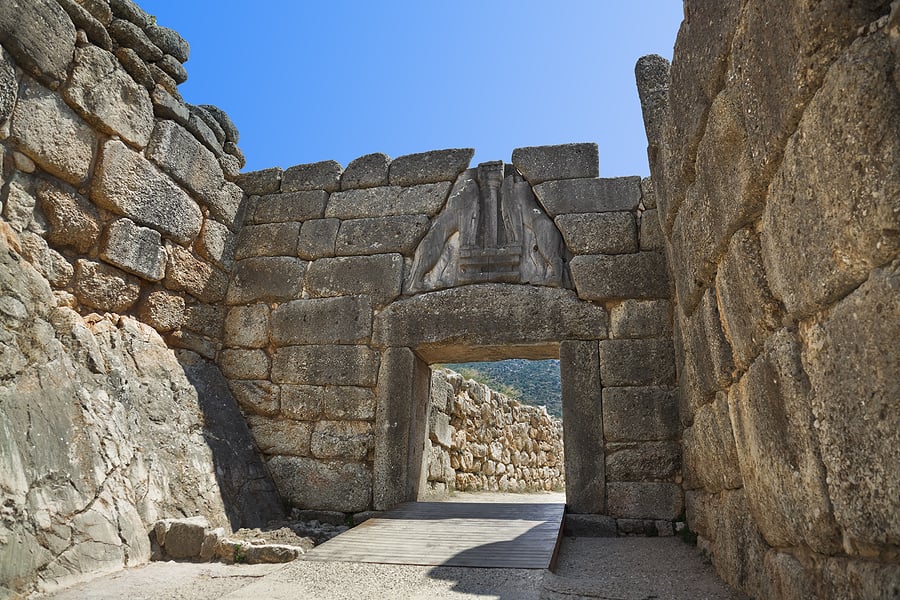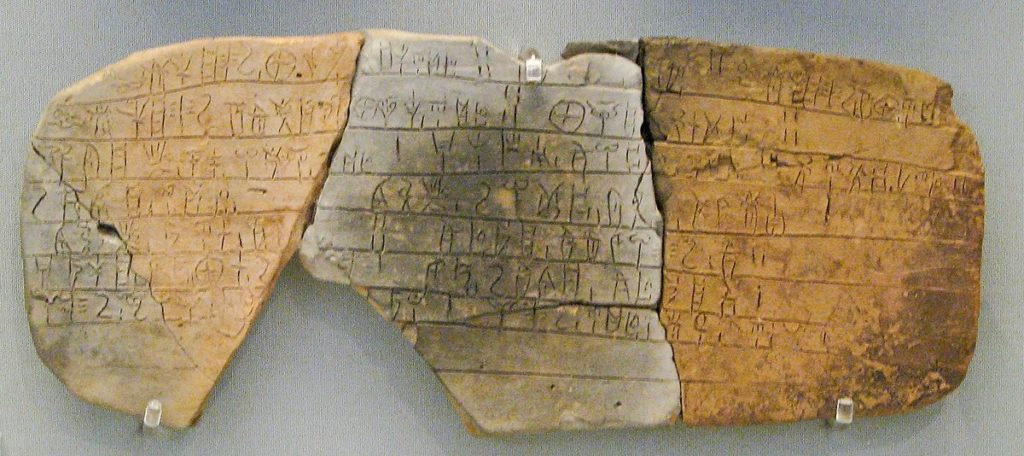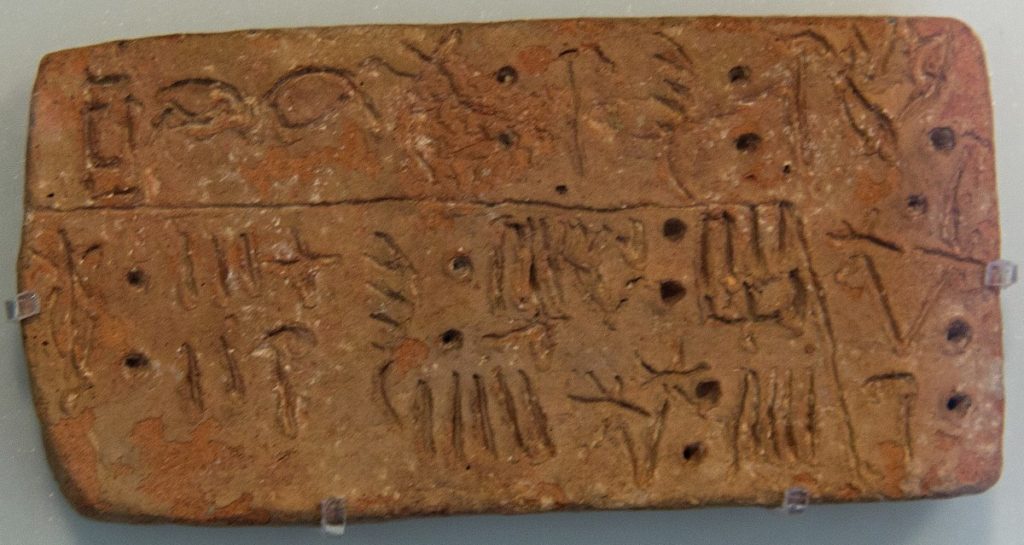
Linear B, the enigmatic script of ancient Greece used by the Mycenaean civilization, has long captivated the minds of experts and enthusiasts alike.
For decades, historians, linguists, and archaeologists have been debating over this fascinating writing system that dominated the Greek world thousands of years ago. Its discovery in the early 20th century in many different archaeological sites across Greece opened a new chapter in understanding the ancient Greek world.
This script, also found in the famous palace of Knossos on Crete, was initially an archaeological riddle, wrapped in the mystery of the Aegean Bronze Age. However, it was eventually deciphered. This revealed its position as the earliest form of written Greek.
Linear B and the story behind it is not just a footnote in the broader archaeological discoveries around ancient Greece. It is the gateway that allowed us into the world of a civilization that laid the groundwork for Classical Greece.
The discovery of Linear B
Linear B tablets with significant writings on them were unearthed decades ago amidst the ruins of ancient palaces. This discovery presented archaeologists with a puzzle that troubled them for decades.
Found in many locations with major historical significance, such as Knossos, Pylos, and Mycenae, these tablets were initially indecipherable. Their discovery tested our knowledge of pre-Classical Greek literacy profoundly. Despite our lack of understanding, however, it did provide us with crucial evidence of a complex society that functioned before the Classical period of Greece.
This society was distinctive and had its own administrative, economic, and possibly religious texts. These were texts that were encoded in a script unlike any other known to modern scholars.

Discovery and significance of Linear B tablets
Linear B was recognized very early on as the oldest-known form of Greek. It provided experts with a direct link to the Mycenaean period, something very significant for our broader understanding of this long-gone civilization. Despite the fact that this era was defined by myth, it became crucial in the evolution of Greek culture as we know it today.
The eventual decipherment of this enigmatic script helped historians to piece together aspects of Mycenaean society that remained unknown to contemporary scholars: from the organization of their beautiful palaces to the gods they worshipped and the products they used the most. This crucial new information about their lives fundamentally changed the way we understand the Aegean Bronze Age. It gave us a clear picture of a truly sophisticated civilization with complex societal structures and established trade networks.
The decipherment of Linear B: A linguistic breakthrough
It wasn’t until the 1950s that we finally managed to understand what was written within these mysterious texts. This happened due to Michael Ventris, an Englishman from Hertfordshire. Ventris was an architect with a great personal passion for linguistics. His groundbreaking interdisciplinary approach led to the revelation that Linear B was a syllabic script. He managed to combine his knowledge from classical studies and linguistics, and along with his amateur enthusiasm, he achieved what seemed—until then—unthinkable.
The script of Greece’s mysterious writing system
The Linear B script comprised approximately two hundred distinctive characters. Experts classified these characters into two main groups: syllabic symbols and ideograms. The syllabic symbols represent sound with ideograms depicting objects or ideas.
The difficult process to standardize these symbols began in Paris in 1956. It then culminated with the adoption of the Wingspread Convention standards of 1961. This happened largely thanks to the contributions of Emmett L. Bennett, Jr, an American classicist and philologist whose systematic catalog of the symbols of the script led to the solution of its reading.
This effort was further solidified with the establishment of the CIPEM, the Permanent International Committee of Mycenaean Studies. The committee collaborated with UNESCO in 1970 to ensure ongoing international cooperation in the field of Mycenaean studies.
According to the findings of the experts, there are numerous similarities between Linear B and Linear A signs. Nonetheless, the latter remains undeciphered and shrouded in mystery.
How Linear B unlocked Mycenaean history and culture
The eventual decipherment of Linear B had a profound impact on the way we understand ancient Greek history. These little tablets have shown us the complexities of the Mycenaean society and its bureaucratic, economic, and religious practices.
Moreover, the study of Linear B has helped us comprehend the continuity and constant change within the Greek language and culture, too.
The Mycenaean civilization controlled a vast territory from Crete to the Cycladic islands. It was influenced by the Minoans but was more militaristic at its core and traded extensively with the Eastern Mediterranean and Egypt. The Linear B tablets and their decoding make evident the complex economic systems and hierarchies within the Mycenaean palaces. They also give us valuable information on the distribution of food, religious offerings, and items that were being produced by the Myceneans.
The decline of the Mycenaean civilization, however, which occurred between 1230 and 1100 BCE, remains a subject of debate. Nonetheless, factors such as warfare with invading conquerors, natural disasters, overpopulation, internal unrest, and that era’s climate change may have contributed to its demise. The disappearance of Linear B coincided with this decline. This left a profound gap in our knowledge of the period until the emergence of the Greek alphabet, which was borrowed from the Phoenicians.

Linear A vs. Linear B: Understanding ancient scripts
While Linear B has been successfully deciphered, revealing its contents and messages as an early form of Greek, its predecessor, Linear A, remains a mystery.
Linear A was used by the Minoans and has managed to remain a mystery to this day. Understanding the link between Linear B and Linear A and decoding the secrets of the latter would allow experts to paint a much more complete picture of the Minoan civilization going back as far as 1,800 BC. It has to be noted that Linear B was used on the Greek mainland and Crete 50 to 150 years later than Linear A.
The enduring legacy of Linear B in Greek archaeology
The story of Linear B and its decoding is proof of the lengths to which scholars will go to uncover the secrets of the ancient world.
Its final decipherment bridged the gap between the Mycenaean age and Classical Greece, a period that had been remained pretty much unknown until recently. This groundbreaking scientific achievement offered us a clearer picture of the lives of people who lived over three millennia ago. As research continues and experts try to decipher Linear A, the legacy of Linear B promises to further our knowledge and understanding of the ancient Greek world.
Let’s not forget that even the smallest fragment of clay can hold the keys to unlocking centuries of human history.
Learn more about the scholars who deciphered Linear B, click here.
See all the latest news from Greece and the world at Greekreporter.com. Contact our newsroom to report an update or send your story, photos and videos. Follow GR on Google News and subscribe here to our daily email!



